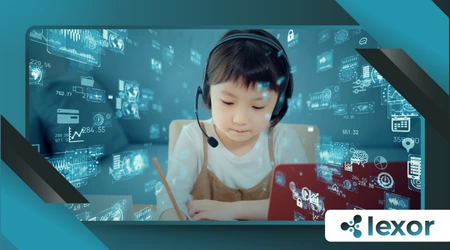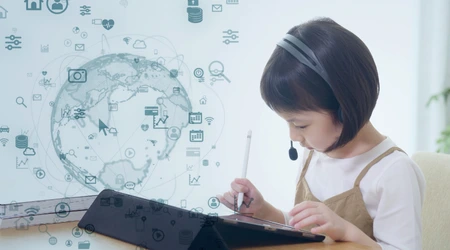The Future of EdTech: What’s Next for Early Education?

The Future of EdTech is reshaping early education, blending innovation with personalized learning to prepare children for a rapidly evolving world.
As we move deeper into 2025, the integration of technology in classrooms is no longer a luxury but a necessity.
From AI-driven platforms to immersive virtual reality experiences, the tools available today are transforming how children learn, think, and interact.
But what does this mean for the future? How can we ensure these advancements are equitable, ethical, and effective?
This article explores the latest trends, challenges, and opportunities in the Future of EdTech, offering a comprehensive look at what’s next for early education.
The Evolution of Early Education
In 2025, early education is no longer confined to traditional classrooms. Interactive tools like AI-driven platforms and immersive VR experiences are transforming how children learn.
These technologies are not just supplementary; they are becoming central to the educational experience.
For instance, platforms like Khan Academy Kids and ABCmouse are using gamified lessons to teach foundational skills.
These tools adapt to each child’s learning pace, ensuring no one is left behind.
Moreover, the shift to digital learning has been accelerated by the pandemic, which highlighted the need for flexible, accessible education solutions.
Schools are now investing heavily in EdTech to future-proof their curricula.
Also Read: Screen time management: healthy tech habits for kids
Personalized Learning Takes Center Stage

EdTech now tailors learning experiences to individual needs. Adaptive algorithms analyze a child’s progress, adjusting content to match their pace and interests.
This personalized approach ensures that every child receives the support they need to thrive.
For example, DreamBox, an adaptive math program, uses real-time data to customize lessons.
If a child struggles with fractions, the platform provides additional exercises and visual aids to reinforce understanding.
This level of customization was unimaginable a decade ago. Today, it’s setting a new standard for early education, making learning more engaging and effective.
+ Educational Robotics: Best Starter Kits for Kids
The Role of AI in Early Education
AI-powered tools like chatbots and virtual tutors are becoming indispensable. They provide instant feedback, making learning interactive and fun.
For instance, tools like Socratic by Google use AI to help students solve problems by breaking them down into manageable steps.
However, ethical concerns about data privacy remain a critical discussion point. Schools and developers must ensure that children’s data is protected and used responsibly.
AI is also helping teachers by automating administrative tasks, allowing them to focus more on instruction and less on paperwork. This dual benefit is driving widespread adoption in early education.
Immersive Technologies: Beyond the Screen
VR and AR are revolutionizing early education. Imagine a child exploring the solar system or diving into the depths of the ocean—all from their classroom.
These technologies make abstract concepts tangible, enhancing comprehension and retention.
For example, Google Expeditions allows students to take virtual field trips to historical sites and natural wonders.
This immersive experience brings lessons to life in ways textbooks never could.
As these technologies become more affordable, their use in early education is expected to grow exponentially, offering endless possibilities for creative learning.
Also Read: How to Build a Diversified Crypto Portfolio in 2025
Gamification: Learning Through Play
Gamified learning platforms are gaining traction. By turning lessons into games, children develop problem-solving skills while staying motivated.
Platforms like Prodigy and Minecraft Education Edition are leading the charge.
These tools align with natural learning instincts, making education enjoyable. For instance, Prodigy uses a fantasy-themed game to teach math, where students solve problems to progress through the story.
This approach not only boosts engagement but also helps children develop critical thinking and collaboration skills, preparing them for future challenges.
The Rise of Parental Involvement Tools
EdTech isn’t just for kids. Apps that keep parents informed about their child’s progress are bridging the gap between home and school.
Tools like ClassDojo and Seesaw provide real-time updates on assignments and achievements.
This transparency fosters collaboration, ensuring consistent support for young learners. Parents can now play a more active role in their child’s education, reinforcing lessons at home.
Moreover, these tools help teachers communicate more effectively with families, creating a stronger support network for students.
Challenges in the Future of EdTech
Despite its potential, EdTech faces hurdles. Accessibility remains a concern, with underserved communities often lacking the necessary infrastructure. Bridging this digital divide is crucial for equitable education.
Additionally, the rapid pace of technological advancement can make it difficult for schools to keep up. Teachers need ongoing training to effectively integrate new tools into their classrooms.
Addressing these challenges requires collaboration between governments, tech companies, and educators to ensure that EdTech benefits all children, regardless of their background.
The Role of Educators in a Tech-Driven World
Teachers are no longer just instructors; they’re facilitators of technology. Professional development programs are essential to help educators integrate EdTech effectively.
For example, organizations like ISTE offer training and resources to help teachers stay ahead of the curve. These programs ensure that technology complements, rather than replaces, human interaction.
Moreover, teachers play a critical role in modeling responsible tech use, teaching students how to navigate the digital world safely and ethically.
Data-Driven Insights for Better Outcomes
Analytics tools are providing unprecedented insights into learning patterns. Schools can now identify gaps and tailor interventions to improve outcomes.
For instance, platforms like BrightBytes analyze data from multiple sources to provide actionable recommendations. This data-centric approach is revolutionizing early education.
However, it’s essential to balance data collection with privacy concerns, ensuring that students’ information is used responsibly and transparently.
The Global Impact of EdTech
EdTech is breaking geographical barriers. Children in remote areas can now access world-class resources, leveling the playing field.
For example, organizations like One Laptop per Child are providing affordable devices to students in developing countries.
This democratization of education is a cornerstone of the Future of EdTech.
Moreover, global collaborations are enabling the sharing of best practices, ensuring that innovations benefit children worldwide.
Balancing Screen Time and Physical Activity
While technology is transformative, balancing screen time with physical play is vital. Hybrid models that combine digital and hands-on learning are emerging as best practices.
For instance, schools are incorporating activities like coding robots or building projects that blend tech with tactile experiences. This ensures holistic development for young learners.
Parents and educators must work together to create a balanced routine that promotes both digital literacy and physical well-being.
The Ethical Implications of EdTech
As technology advances, ethical considerations must keep pace. Protecting children’s data and ensuring equitable access are non-negotiable priorities.
For example, the Children’s Online Privacy Protection Act (COPPA) in the U.S. sets guidelines for data collection, but enforcement remains a challenge.
Stakeholders must collaborate to create a safe, inclusive digital learning environment that prioritizes children’s well-being.
The Role of Governments and Policymakers
Governments play a pivotal role in shaping the Future of EdTech. Policies that promote innovation while safeguarding privacy are essential.
For instance, the European Union’s General Data Protection Regulation (GDPR) sets a high standard for data protection, influencing global practices.
Public-private partnerships can drive sustainable growth in this sector, ensuring that EdTech benefits all stakeholders.
Table 1: Global EdTech Investment Trends (2020-2025)
| Year | Investment (in billions) |
|---|---|
| 2020 | $16.1 |
| 2021 | $18.7 |
| 2022 | $21.3 |
| 2023 | $23.4 |
| 2024 | $25.0 |
| 2025 | $27.5 (projected) |
The Power of Collaboration
EdTech’s success hinges on collaboration between developers, educators, and parents. By working together, we can create solutions that truly meet children’s needs.
For example, co-creation workshops involving teachers and tech developers are becoming more common, ensuring that tools are practical and effective.
This synergy is key to unlocking the full potential of technology in early education.
Looking Ahead: What’s Next?
The Future of EdTech is bright, with advancements like quantum computing and neural interfaces on the horizon. These innovations promise to further personalize and enhance learning.
For instance, neural interfaces could one day allow direct brain-to-computer communication, revolutionizing how we process information.
However, the focus must remain on creating meaningful, impactful experiences for young learners, ensuring that technology serves as a tool for empowerment.
Conclusion
The Future of EdTech is not just about technology; it’s about empowering the next generation. By embracing innovation while addressing challenges, we can create a brighter future for early education.
From personalized learning to immersive technologies, the possibilities are endless. But success depends on collaboration, equity, and a commitment to ethical practices.
As we look ahead, one thing is clear: the Future of EdTech holds the key to unlocking every child’s potential, ensuring they are prepared to thrive in an ever-changing world.
Table 2: Benefits of Gamified Learning
| Benefit | Impact |
|---|---|
| Engagement | Increases motivation and participation |
| Skill Development | Enhances problem-solving and critical thinking |
| Retention | Improves memory and understanding |
Frequently Asked Questions (FAQs)
1. What is the Future of EdTech in early education?
The Future of EdTech in early education focuses on personalized, immersive, and equitable learning experiences powered by AI, VR, and gamification.
2. How does AI benefit early education?
AI provides personalized learning paths, instant feedback, and automates administrative tasks, allowing teachers to focus more on instruction.
3. Are there risks associated with EdTech?
Yes, risks include data privacy concerns, screen time management, and ensuring equitable access to technology.
4. How can parents support EdTech at home?
Parents can use tools like ClassDojo to stay informed and create a balanced routine that combines digital and hands-on learning.
5. What role do governments play in EdTech?
Governments set policies to promote innovation, protect data privacy, and ensure equitable access to EdTech resources.
By staying ahead of trends and addressing challenges, the Future of EdTech will continue to redefine early education, ensuring every child has the tools to thrive.
